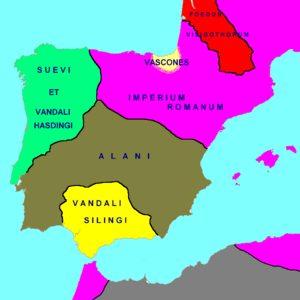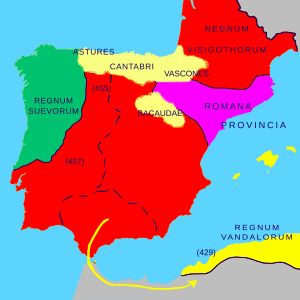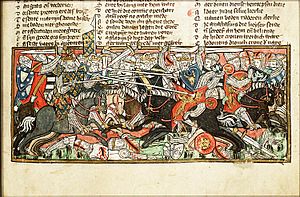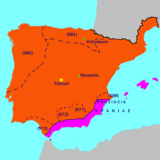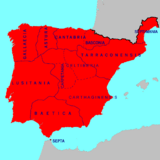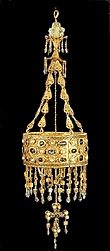Visigothic Kingdom facts for kids
Quick facts for kids
Kingdom of the Visigoths
Regnum Gothorum (Latin)
|
|||||||||||||
|---|---|---|---|---|---|---|---|---|---|---|---|---|---|
| 418–c. 721 | |||||||||||||
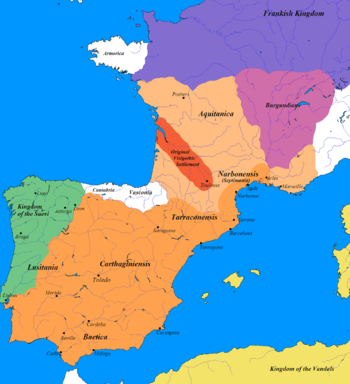
Extent of the Visigothic Kingdom, c. 500 (total extent shown in orange, territory lost after Battle of Vouillé shown in light orange: Kingdom of the Suebi was annexed in 585).
|
|||||||||||||
| Capital | |||||||||||||
| Common languages |
|
||||||||||||
| Religion |
|
||||||||||||
| Government | Monarchy | ||||||||||||
| King | |||||||||||||
|
• 415–418
|
Wallia | ||||||||||||
|
• 418–451
|
Theodoric I | ||||||||||||
|
• 466–484
|
Euric | ||||||||||||
| History | |||||||||||||
| 410 | |||||||||||||
|
• Established
|
418 | ||||||||||||
| 451 | |||||||||||||
| 507 | |||||||||||||
|
• Annexation of the Suebic Kingdom
|
585 | ||||||||||||
|
• Conquest of Byzantine Spania
|
624 | ||||||||||||
|
• Battle of Guadalete and Umayyad conquest of Toledo
|
711 | ||||||||||||
|
• Umayyad occupation of
Septimania |
c. 721 | ||||||||||||
| Area | |||||||||||||
| 484 | 500,000 km2 (190,000 sq mi) | ||||||||||||
| 580 | 600,000 km2 (230,000 sq mi) | ||||||||||||
|
|||||||||||||
| Today part of | Portugal Spain Andorra France |
||||||||||||
The Visigothic Kingdom was a powerful kingdom that existed from the 5th to the 8th centuries. It covered what is now southwestern France and the Iberian Peninsula (modern-day Spain and Portugal). The Visigoths were a Germanic group. They helped the Western Roman Empire and were given land in Gaul (France). Later, they took over all of Hispania (Spain and Portugal).
The Visigoths were originally from central Europe. They had adopted many Roman customs. They were allies of Rome, called foederati, meaning they helped Rome fight other groups like the Vandals and Suebi. When the Western Roman Empire fell in 476 AD, the Visigoths believed they had the right to control the lands Rome had promised them.
Under King Euric, the Visigoths grew stronger. They expanded their territory from Gaul into southern France. They also took control of much of southern Gaul. Their first capital was Toulouse. Because of this, the kingdom is sometimes called the Kingdom of Toulouse.
In the early 6th century, the Visigoths lost most of their French lands to the Franks. Only a small coastal area called Septimania remained. The capital then moved to Toledo in Hispania. This later period is sometimes called the Kingdom of Toledo.
The Visigoths also fought against the Byzantine Empire. The Byzantines tried to take back parts of southern Hispania. But by 624, King Swinthila had pushed them out completely. King Liuvigild also conquered the Kingdom of the Suebi in 585. He also fought against the Basques.
Over time, the Visigoths and the local Hispano-Roman people became one. The Gothic language slowly disappeared. This new unity led to stricter laws, especially against Jews. The Visigothic Code, a set of laws, was finished in 654. It applied to everyone, both Goths and Hispano-Romans.
The 7th century saw many civil wars among the nobles. Despite this, the Visigoths pushed the Byzantines out of Hispania by 625 AD. In 711 AD, most of the Visigothic Kingdom was conquered by Umayyad troops from North Africa. Only the northern parts of Hispania remained Christian. These areas later formed the Kingdom of Asturias.
The early Visigothic kings followed a Christian belief called Arianism. This caused problems with the Catholic Church. But after they converted to Nicene Christianity, the Church became very powerful. It influenced the kingdom's laws through meetings called the Councils of Toledo. The Visigoths also created the Visigothic Code. This legal code was very important for Spanish law throughout the Middle Ages.
Contents
History of the Visigothic Kingdom
Early Visigothic Kingdom
Between 407 and 409 AD, groups like the Vandals, Alans, and Suebi crossed the Rhine River. They moved through France and into the Iberian Peninsula. Meanwhile, the Visigoths under Alaric famously sacked Rome in 410. They captured Galla Placidia, the Roman emperor's sister.
Athaulf, who was king from 410 to 415, worked in Gaul and Hispania. He used diplomacy to play different groups against each other. He took cities like Narbonne and Toulouse. After he married Placidia, Emperor Honorius asked him for help. He wanted the Visigoths to regain Roman control of Hispania from other groups.
In 418, Honorius rewarded the Visigoths under King Wallia. He gave them land in the Garonne valley in Gaul to settle. The Visigoths likely received taxes from this region. Local nobles then paid their taxes to the Visigoths instead of Rome.
The Visigoths, with their capital at Toulouse, were mostly independent. They soon began to expand into Roman lands. Under Theodoric I (418–451), the Visigoths attacked cities like Arles and Narbonne. They were sometimes stopped by Roman forces. But in 439, the Visigoths defeated Roman and Hunnic forces at the Battle of Toulouse.
By 451, the situation changed. The Huns invaded Gaul. Theodoric I fought alongside the Romans against Attila the Hun at the Battle of the Catalaunian Plains. Attila was driven back, but Theodoric died in the battle.
The Vandals conquered North Africa in 439. The Suebi took most of Hispania. Roman Emperor Avitus sent the Visigoths into Hispania. Theodoric II (453–466) defeated the Suebi king in 456. He then sacked the Suebi capital, Braga. The Goths were very harsh in Gallaecia. They killed many people and attacked holy places. Theodoric took control of southern Hispania. In 461, the Goths received the city of Narbonne from the emperor.
Kingdom of Toulouse Expands
In 466, Euric became the Visigothic king. He was the youngest son of Theodoric I. Euric expanded the Visigothic lands in Gaul. He also made their control stronger in Hispania. Euric fought wars with the Suebi and took most of their region. He captured Mérida in 469.
Euric also attacked the Western Roman Empire. He captured Hispania Tarraconensis in 472. This was the last Roman stronghold in Spain. By 476, his rule reached the Rhone and Loire rivers. This covered most of southern Gaul. He also took important Roman cities like Arles and Marseilles.
The Visigothic Kingdom was officially recognized as independent in 475. This happened when Emperor Julius Nepos signed a treaty with Euric. Euric gained lands in Gaul in exchange for military service. The lands in Hispania remained under Visigothic control. After the last Roman emperor was removed, Euric quickly took back Provence.
By 500, the Visigothic Kingdom was centered at Toulouse. It controlled much of Gaul and most of Hispania. Only the Suebic Kingdom of Galicia and small areas held by local Iberian groups remained independent. Euric's son Alaric II (484–507) created new laws. He also held a church meeting at Agde.
The Visigoths then clashed with the Franks under King Clovis I. Clovis had conquered northern Gaul. After a short war, Alaric had to stop a rebellion in Tarraconensis. This was likely due to Visigoth people moving into Hispania. In 507, the Franks attacked again, allied with the Burgundians. Alaric II was killed at the Battle of Vouillé near Poitiers. Toulouse was sacked. By 508, the Visigoths had lost most of their French lands, except for Septimania.
Visigothic Hispania: Arian and Catholic Eras
After Alaric II died, his son Gesalec became king. But he was removed by Theodoric the Great, ruler of the Ostrogothic Kingdom. Theodoric invaded and defeated Gesalec at Barcelona. Gesalec was later captured and killed. Theodoric then made his grandson Amalaric (511–531) king. Amalaric was a child, so power stayed with an Ostrogothic general named Theudis. Amalaric only gained full control after Theodoric died in 526. His rule was short. In 531, Amalaric was defeated by the Frankish king Childebert I and killed.
After Amalaric, Theudis (531–548) became king. He expanded Visigothic control in the south. But he was also murdered after a failed invasion of Africa. Visigothic Spain then had a civil war under King Agila I (549–554). This led the Byzantine emperor Justinian I to send an army. They took a small province called Spania along the southern coast of Spain. Agila was eventually killed. His enemy Athanagild (552–568) became the new king. He attacked the Byzantines but could not remove them from southern Spain.
The next Visigothic king was Liuvigild (569–586). He was a strong military leader. He made Visigothic power stronger in Spain. Liuvigild fought against the Byzantines in the south. He took back Cordova. He also fought in the north against the Suebi Kingdom and other small independent groups. He brought peace to northern Spain but could not fully conquer these people.
Liuvigild made his son Hermenegild a joint ruler. This led to a civil war between them. Hermenegild was the first Visigothic king to convert to Nicene Christianity. But he was defeated in 584 and killed in 585. By the end of his rule, Liuvigild had united the entire Iberian Peninsula. He conquered the Suebic Kingdom in 585. Liuvigild also founded new cities, like Reccopolis and Victoriacum (Vitoria). He was the first barbarian king to do this.
The Catholic Kingdom of Toledo
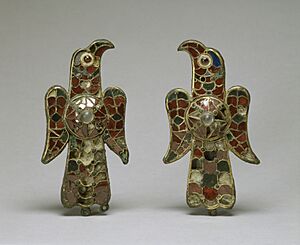
When Reccared I (586–601) became king, he converted from Arianism to Chalcedonian Christianity. This caused some problems in the kingdom. But Reccared put down a revolt. He also stopped another Frankish attack. Reccared then led the Third Council of Toledo in 589. There, he announced his belief in the Nicene creed and rejected Arianism. He took on the name Flavius, like the Roman emperors. Reccared also fought the Byzantines.
Reccared's son Liuva II became king in 601. But he was removed by the Visigothic noble Witteric (603–610). This ended Reccared's family rule. Several Visigothic kings ruled between 610 and 631. This time saw many kings being killed. During this period, the Byzantine lands in the south were finally conquered. Wars continued in the north against the Basques and Asturians.
King Sisebut (612–621) passed harsh laws against Jews. He forced many Jews to convert to Christianity. Sisebut also won against the Byzantines, taking several cities. The Byzantines were finally defeated by Swinthila (621–631). He captured all their Spanish lands by 625. Swinthila was later removed from power.
The instability of this time was due to power struggles between kings and nobles. Religious unity made the church stronger. It used church councils in Toledo to exercise its power. The fourth council in 633 removed King Sisinand. It replaced him with Chintila (636–639). The church councils became very powerful. They controlled how kings were chosen. They also decided to meet regularly to discuss church and political matters. They wanted kings to die peacefully and declared them sacred. But despite this, Chintila was removed in 639. The council then elected Chindaswinth as king.
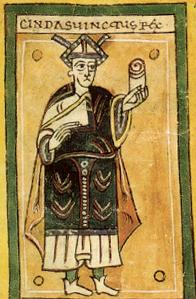
The reigns of Chindaswinth and his son Recceswinth saw the creation of an important law book. It was called the Liber Iudiciorum (Book of Judgements). King Chindaswinth started it in 642. His son, King Recceswinth (649–672), finished it in 654. This law book ended the old system of different laws for Hispano-Romans and Visigoths. The new laws applied to everyone. It replaced all older laws. The code was mostly based on Roman law. It also included some new laws. The harsh laws against Jews were removed.
The Liber showed that the old system of military and civil divisions was changing. Dukes and counts took on more duties. The king's servants also gained much power. With these laws, women could inherit land and titles. They could manage their property independently. They could also write wills if they had no heirs. Women could represent themselves in court at age 14. They could arrange their own marriages at age 20.
Chindaswinth (642–653) made the monarchy stronger. He executed about 700 nobles. He forced important people to swear loyalty. He also said he could remove clergy who acted against the government. He managed to get his son Recceswinth on the throne. Recceswinth (653–672) held another council. It reduced punishments for treason. It also confirmed the councils' power to elect kings.
After Recceswinth, King Wamba (672–680) was elected. He faced revolts and reformed the army. He made a law that all military leaders and bishops had to help the kingdom in danger. Wamba was later removed from power peacefully. King Ervig (680–687) held more church councils. He removed Wamba's harsh laws but still planned for the army. Ervig's son-in-law Egica became king. In 694, a council passed harsh laws against Jews. Many were enslaved. Egica also made his son Wittiza a co-ruler in 698. Not much is known about Wittiza's rule. A civil war soon broke out between his sons and King Roderic.
The Muslim Conquest of Hispania
In 711, Tariq ibn Ziyad, a Muslim Berber leader, invaded Spain. He had about 7,000 men. King Roderic was in the north fighting the Basques. A story says that Julian, Count of Ceuta, helped the invasion. This was because Roderic had dishonored his daughter. This story might not be true.
By late July, a battle happened at the Guadalete River. Roderic was betrayed by his own troops. He was killed in battle. The Muslims then took much of southern Spain easily. They captured Toledo and killed several Visigothic nobles. In 712, Musa, the governor of Islamic Africa, arrived with another army of 18,000. He took Mérida in 713. He invaded the north, taking Saragossa and León in 714.
By 716, most of the Iberian Peninsula was under Islamic rule. Septimania was taken between 721 and 725. The only strong resistance was in Asturias. A Visigothic noble named Pelagius revolted in 718. He defeated the Muslims at the battle of Covadonga. This was the start of the Reconquest, a long period of Christian kingdoms fighting to retake Spain.
Many Hispano-Gothic nobles fled to Asturias or Septimania. In Asturias, they supported Pelagius's uprising. They joined with local leaders to form a new noble class. The people in the mountains were native Astures, Galicians, Cantabri, and Basques. They had not fully mixed with Hispano-Gothic society.
Resistance also continued near the Pyrenees mountains. The Berbers settled in the south and central Spain. At first, Muslims generally allowed Christians to practice their religion. However, non-Muslims had to follow Islamic law and were treated as second-class citizens.
Visigothic Settlements
Visigothic settlements were mostly along the Garonne River in Aquitaine during the 5th century. They were allies of the Roman Empire. They were given places to stay for Roman soldiers.
Later, after King Euric expanded the kingdom, many Goths settled more freely. They settled around Roman cities like Mérida, Barcelona, Seville, Toledo, and Narbonne. These cities became important centers of Visigothic power. Other settlements were in farming areas between the Douro, Ebro, and Tagus rivers. This area was known as Campi Gothorum. After the Kingdom of the Suebi fell, some Goths settled near the Tagus river north of Lisbon. Little Visigothic settlement happened elsewhere.
Founding New Cities
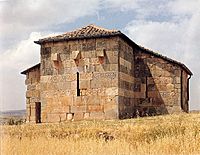
The Visigoths founded the only new cities in Western Europe between the 5th and 8th centuries. They founded at least four cities. A fifth city is mentioned by a later Arabic source. All these cities were built for military reasons. Three of them celebrated victories.

The first city, Reccopolis, was founded by Liuvigild in 578. This was after his victory over the Franks. He named it after his son Reccared. It was built like Byzantine cities, with a palace and a mint. But it was in ruins by the 9th century.
Liuvigild also founded a city called Victoriacum. He named it after his victory over the Basques. Some think it is the modern city of Vitoria. But 12th-century sources say Vitoria was founded later.
Liuvigild's son founded his own city around 600. It was called Lugo id est Luceo in Asturias. It was built after a victory over the Asturians or Cantabrians.
The fourth Visigothic city was Ologicus. It was built in 621 by Swinthila. It was a fort against the Basques. It is likely modern Olite.
A possible fifth city is Baiyara. It is mentioned as founded by Reccared. It might be modern Montoro.
Culture and Legacy
Some people used to think the Visigothic rule was part of the "Dark Ages". This was seen as a time when culture and science declined. But in reality, the Visigoths helped preserve classical culture. For example, the bathing culture in Andalusia, often linked to Muslims, continued from Roman-Visigothic traditions.
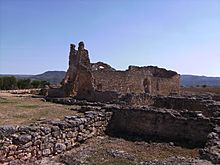
Visigothic Mérida had baths with water from Roman aqueducts. Aqueducts were also in Cordoba, Cadiz, and Recopolis. Digs show that Recopolis and Toledo, the Visigothic capital, were influenced by Byzantine architecture. When Muslims conquered Spain, they were amazed by the many fine Visigothic treasures. Some treasures were saved because they were buried during the invasion. An example is the votive crowns from the treasure of Guarrazar.
Only senior monks could read books by non-Christian authors. But this did not stop great thinkers from rising. Isidore of Seville was one of the most famous scholars of the Middle Ages. He wrote many books, including his Etymologies. This was an encyclopedia of knowledge from his time. It was known and translated across medieval Europe. Other scholars included Eugenius I of Toledo, an expert in mathematics and astronomy. Theodulf of Orléans, a theologian and poet, later helped with the Carolingian Renaissance. A Muslim source called Visigothic Seville the "abode of the sciences."
A text from the 7th century shows that Visigothic nobles were taught reading, writing, medicine, law, and philosophy. King Sisebut was a good example of an educated noble. He supported learning and wrote poems, including one about astronomy.
List of Kings
Early Kings (Pagans)
These kings and leaders were pagans, except for Fritigern and possibly Alavivus.
- Ariaric
- Aoric
- Athanaric (369–381)
- Alavivus (c. 376)
- Fritigern (c. 376–c. 380)
Balti Dynasty (Arian Christians)
These kings were Arians. They often passed the throne to their sons or close relatives.
- Alaric I (395–410)
- Athaulf (410–415)
- Sigeric (415)
- Wallia (415–418)
- Theodoric I (418–451)
- Thorismund (451–453)
- Theodoric II (453–466)
- Euric (466–484)
- Alaric II (484–507)
- Gesalec (507–511)
- Amalaric (511–531)
Later Kings (Arian and Catholic)
After the Balti family, kings were chosen by election. The monarchy remained Arian until Reccared I converted in 587.
- Theudis (531–548)
- Theudigisel (548–549)
- Agila I (549–554)
- Athanagild (554–568)
- Liuva I (568–572)
- Liuvigild (569–586)
- Reccared I (580–601), first Catholic king
- Liuva II (601–603)
- Witteric (603–610)
- Gundemar (610–612)
- Sisebut (612–621)
- Reccared II (621)
- Swinthila (621–631)
- Sisenand (631–636)
- Chintila (636–640)
- Tulga (640–641)
- Chindaswinth (641–653)
- Recceswinth (649–672)
- Wamba (672–680)
- Erwig (680–687)
- Egica (687–702)
- Wittiza (694–710)
- Roderic (710–711)
- Agila II (711–714)
- Ardo (714–721)
Family tree
| Kings of the Visigoths family tree | |||||||||||||||||||||||||||||||||||||||||||||||||||||||||||||||||||||||||||||||||||||||||||||||||||||||||||||||||||||||||||||||||||||||||||||||||||||||||||||||||||||||||||||||||||||||||||||||||||||||||||||||||||||||||||||||||||||||||||||||||||||||||||||||||||||||||||||||||||||||||||||||||||||||||||||||||||||||||||||||||||||||||||||||||||||||||||||||||||||||||||||||||||||||||||||||||||||||||||||||||||||||||||||||||||||||||||||||||||||||||||||||||||||||||||||||||||||||||||||||||||||||||||||||||||||||||||||||||||||||||||||||||||||||||||||||||||||||||||||||||||||||||||||||||||||||||||||||||||||||||||||||||||||||||||||||||||||||||||||||||||||||||||||||||||||||||||||||||||||||||||||||||||||||||||||||||||||||||||||||||||||||||||||||||||||||||||||||||||||||||||||||||||||||||||||||||||||||||||||||||||||||||||||||||||||||||||||||||||||||||||||||||||||||||||||||||||||||||||||||||||||||||||||||||||||||||||||||||||||||||||||||||||||||||||||||||||||||||||||||||||||||||||||||||||||||||||||||||||||||
|---|---|---|---|---|---|---|---|---|---|---|---|---|---|---|---|---|---|---|---|---|---|---|---|---|---|---|---|---|---|---|---|---|---|---|---|---|---|---|---|---|---|---|---|---|---|---|---|---|---|---|---|---|---|---|---|---|---|---|---|---|---|---|---|---|---|---|---|---|---|---|---|---|---|---|---|---|---|---|---|---|---|---|---|---|---|---|---|---|---|---|---|---|---|---|---|---|---|---|---|---|---|---|---|---|---|---|---|---|---|---|---|---|---|---|---|---|---|---|---|---|---|---|---|---|---|---|---|---|---|---|---|---|---|---|---|---|---|---|---|---|---|---|---|---|---|---|---|---|---|---|---|---|---|---|---|---|---|---|---|---|---|---|---|---|---|---|---|---|---|---|---|---|---|---|---|---|---|---|---|---|---|---|---|---|---|---|---|---|---|---|---|---|---|---|---|---|---|---|---|---|---|---|---|---|---|---|---|---|---|---|---|---|---|---|---|---|---|---|---|---|---|---|---|---|---|---|---|---|---|---|---|---|---|---|---|---|---|---|---|---|---|---|---|---|---|---|---|---|---|---|---|---|---|---|---|---|---|---|---|---|---|---|---|---|---|---|---|---|---|---|---|---|---|---|---|---|---|---|---|---|---|---|---|---|---|---|---|---|---|---|---|---|---|---|---|---|---|---|---|---|---|---|---|---|---|---|---|---|---|---|---|---|---|---|---|---|---|---|---|---|---|---|---|---|---|---|---|---|---|---|---|---|---|---|---|---|---|---|---|---|---|---|---|---|---|---|---|---|---|---|---|---|---|---|---|---|---|---|---|---|---|---|---|---|---|---|---|---|---|---|---|---|---|---|---|---|---|---|---|---|---|---|---|---|---|---|---|---|---|---|---|---|---|---|---|---|---|---|---|---|---|---|---|---|---|---|---|---|---|---|---|---|---|---|---|---|---|---|---|---|---|---|---|---|---|---|---|---|---|---|---|---|---|---|---|---|---|---|---|---|---|---|---|---|---|---|---|---|---|---|---|---|---|---|---|---|---|---|---|---|---|---|---|---|---|---|---|---|---|---|---|---|---|---|---|---|---|---|---|---|---|---|---|---|---|---|---|---|---|---|---|---|---|---|---|---|---|---|---|---|---|---|---|---|---|---|---|---|---|---|---|---|---|---|---|---|---|---|---|---|---|---|---|---|---|---|---|---|---|---|---|---|---|---|---|---|---|---|---|---|---|---|---|---|---|---|---|---|---|---|---|---|---|---|---|---|---|---|---|---|---|---|---|---|---|---|---|---|---|---|---|---|---|---|---|---|---|---|---|---|---|---|---|---|---|---|---|---|---|---|---|---|---|---|---|---|---|---|---|---|---|---|---|---|---|---|---|---|---|---|---|---|---|---|---|---|---|---|---|---|---|---|---|---|---|---|---|---|---|---|---|---|---|---|---|---|---|---|---|---|---|---|---|---|---|---|---|---|---|---|---|---|---|---|---|---|---|---|---|---|---|---|---|---|---|---|---|---|---|---|---|---|---|---|---|---|---|---|---|---|---|---|---|---|---|---|---|---|---|---|---|---|---|---|---|---|---|---|---|---|---|---|---|---|---|---|---|---|---|---|---|---|---|---|---|---|---|---|---|---|---|---|---|---|---|---|---|---|---|---|---|---|---|---|---|---|---|---|---|---|---|---|---|---|---|---|---|---|---|---|---|---|---|---|---|---|---|---|---|---|---|---|---|---|---|---|---|---|---|---|---|---|---|---|---|---|---|---|---|---|---|---|---|---|---|---|---|---|---|---|---|---|---|---|---|---|---|---|---|---|---|---|---|---|---|---|---|---|---|---|---|---|---|---|---|---|---|---|---|---|---|---|---|---|---|---|---|---|---|---|---|---|---|---|---|---|---|---|---|---|---|---|---|---|---|---|---|---|---|---|---|---|---|---|---|---|---|---|---|---|---|---|---|---|---|---|---|---|---|---|---|---|---|---|---|---|---|---|---|---|---|---|---|---|---|---|---|---|---|---|---|---|---|---|---|---|---|---|---|---|---|---|---|---|---|---|---|---|---|---|---|---|---|---|---|---|---|---|---|---|---|---|---|---|---|---|---|---|---|---|---|---|---|---|---|---|---|---|---|---|---|---|---|---|---|---|---|---|---|---|---|---|---|---|---|---|---|---|---|---|---|---|---|---|---|---|---|---|---|---|---|---|---|---|---|---|---|---|---|---|---|---|---|---|---|---|---|---|---|---|---|---|---|---|---|---|---|---|---|
|
|||||||||||||||||||||||||||||||||||||||||||||||||||||||||||||||||||||||||||||||||||||||||||||||||||||||||||||||||||||||||||||||||||||||||||||||||||||||||||||||||||||||||||||||||||||||||||||||||||||||||||||||||||||||||||||||||||||||||||||||||||||||||||||||||||||||||||||||||||||||||||||||||||||||||||||||||||||||||||||||||||||||||||||||||||||||||||||||||||||||||||||||||||||||||||||||||||||||||||||||||||||||||||||||||||||||||||||||||||||||||||||||||||||||||||||||||||||||||||||||||||||||||||||||||||||||||||||||||||||||||||||||||||||||||||||||||||||||||||||||||||||||||||||||||||||||||||||||||||||||||||||||||||||||||||||||||||||||||||||||||||||||||||||||||||||||||||||||||||||||||||||||||||||||||||||||||||||||||||||||||||||||||||||||||||||||||||||||||||||||||||||||||||||||||||||||||||||||||||||||||||||||||||||||||||||||||||||||||||||||||||||||||||||||||||||||||||||||||||||||||||||||||||||||||||||||||||||||||||||||||||||||||||||||||||||||||||||||||||||||||||||||||||||||||||||||||||||||||||||||
See also
 In Spanish: Reino visigodo para niños
In Spanish: Reino visigodo para niños
- Romano-Germanic culture
- Councils of Toledo
- Germanic peoples
- Arianism
Sources
- Bachrach, Bernard S. "A Reassessment of Visigothic Jewish Policy, 589–711." American Historical Review 78, no. 1 (1973): 11–34.
- Collins, Roger. The Arab Conquest of Spain, 710–797. Oxford: Blackwell Publishers, 1989. Reprinted 1998.
- Collins, Roger. Law, Culture, and Regionalism in Early Medieval Spain. Great Yarmouth: Variorum, 1992. ISBN: 0-86078-308-1.
- Collins, Roger. Visigothic Spain, 409–711. Oxford: Blackwell Publishing, 2004. ISBN: 0-631-18185-7.
- Heather, Peter. The Goths. Oxford: Blackwell Publishers, 1996.
- James, Edward, ed. Visigothic Spain: New Approaches. Oxford: Oxford University Press, 1980. ISBN: 0-19-822543-1.
- Lacarra, José María. Estudios de alta edad media española. Valencia: 1975.
- Martínez Jiménez, Javier; Isaac Sastre de Diego; Carlos Tejerizo García. (2018) The Iberian Peninsula between 300 and 850. An Archaeological Perspective. Late Antique and Early Medieval Iberia 6. Amsterdam: Amsterdam University Press. ISBN: 9789089647771
- Sivan, Hagith. "On Foederati, Hospitalitas, and the Settlement of the Goths in A.D. 418." American Journal of Philology 108, no. 4 (1987): 759–772.
- Thompson, E. A. "The Barbarian Kingdoms in Gaul and Spain", Nottingham Mediaeval Studies, 7 (1963:4n11).
- Thompson, E. A. The Goths in Spain. Oxford: Clarendon Press, 1969.
- Wallace-Hadrill, John Michael. The Barbarian West, 400–1000. 3rd ed. London: Hutchison, 1967.



